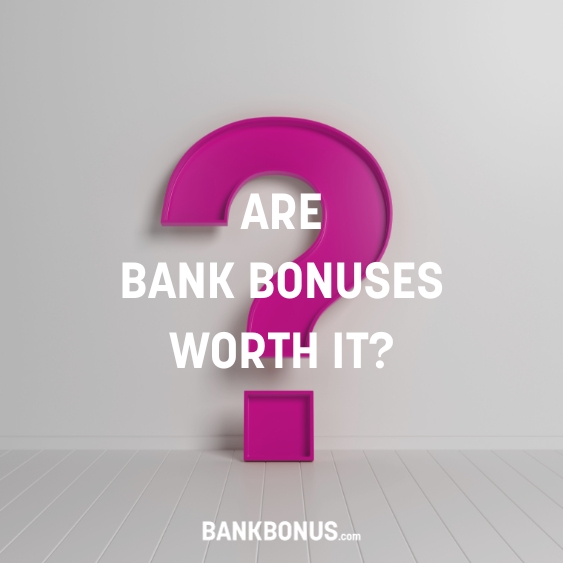Many banks and credit unions will offer competitive welcome bonuses to new customers within the first few months of opening an account, but there are almost always specific requirements you have to meet to reap these rewards.
If you haven’t tracked your spending or expenses before, you may need to get creative to satisfy your bank’s minimum spending requirements.
Let’s take a look at some strategies you can use to lock in your new bank account’s bonus opportunities.
What Are Current Minimum Spend Requirements?
Every card issuer and bank account has its own minimum spend requirements, and you may not pay much attention to them at face value.
However, some debit cards and checking accounts offer enticing sign-on bonuses when you meet certain requirements.
Let’s take a look at a few banks and their most basic checking account options, so you have a baseline for the industry standards for welcome bonuses.
| Card Issuer | Min. Spend | Welcome Bonus | Transaction Requirements |
| Chase | $500 | $200 | Within 90 days of enrollment |
| Capital One | $500 | $350 | At least 2 deposits of $250 or more within a 75-day period |
| PNC | $500 | $400 | 5 or more transactions, at least a $500 deposit |
| TD Bank | $2,500 | $300 | Within 60 days |
| Wells Fargo | $1,025 | $300 | Within 90 days |
10 Creative Ways to Meet Debit Card Usage Requirements
Here are ten strategies you can use to ensure you meet your new debit card’s minimum spend requirements.
- Make Partial or Complete Payments on Utility Bills
- Donate to Causes You Care About
- Reload an Amazon Gift Card
- Make Your Estimated Quarterly Tax Payment
- Use Your Card at the Gas Station
- Buy Your Staples at the Grocery Store
- Treat Your Friends or Family
- Purchase a Prepaid Card or Money Order
- Make an Extra Student Loan or Mortgage Payment
- Fund Your Credit Card
1. Make Partial or Complete Payments on Utility Bills
You can pay some monthly bills using your debit card. You may be able to pay your water, electrical, cell phone, and cable bills with a debit or credit card.
Review your service providers’ payment processing systems and consider setting up an automatic debit transaction for your monthly bills so you don’t have to worry about monitoring your usage.
2. Donate to Causes You Care About
Many charities accept donations for as little as $1. The processing fees associated with debit cards are lower than those associated with credit cards, but you’ll want to double-check because some point-of-sales systems don’t differentiate.
Some charities have special agreements with the processors so these fees don’t apply at all. With some charities, you can set up a recurring monthly payment, so you can support them year-round without a second thought.
3. Reload an Amazon Gift Card
You can buy or reload an Amazon gift card for as little as 50 cents up to $2,000. There are no fees, and since it’s sent by email, you don’t pay for shipping. You can reload your gift card from your debit card as often as you want and continue to make your everyday Amazon purchases with ease.
4. Make Your Estimated Quarterly Tax Payment
If you’re a small business owner, you may not have a dedicated bank account for business expenses yet. In this case, you can use your personal checking account and its associated debit card to submit your quarterly tax payments to the IRS.
Because these payments are only a rough estimate of your annual income, you can pay as much or as little as your current cash flow allows. However, we generally recommend proactive tax planning by setting aside a set percentage of your earnings from every deposit.
5. Use Your Card at the Gas Station
You can use your debit card to get gas and support other transportation expenses. You can take care of your vehicle by keeping up with regular maintenance, including car washes, oil changes, and fluid top-offs. Staying on top of vehicle maintenance mitigates the risk of mechanical failures down the line.
Getting gas and regularly maintaining your vehicle can be a small but vital habit that allows you to meet your minimum spend requirements while reducing your future expenses.
6. Buy Your Staples at the Grocery Store
Use your debit card to purchase items you know you’re going to need eventually, things you can buy in bulk, such as toilet paper, paper towels, and other groceries. When you spend on home essentials you are guaranteed to need in the future, you’re frontloading your budget, so you don’t have to worry about having money for those items in the future.
7. Treat Your Friends or Family
If you have an excuse to ask your friends or family out to celebrate at a restaurant, bar, or other entertainment expenses, putting your card down first can be a surefire way to get a large enough transaction on your statement to satisfy minimum spend requirements.
You don’t even have to shell out long-term. While you can pay for everyone without a second thought, you can ask your friends to Venmo, CashApp, or PayPal their portion of the bill so you can recoup those funds later.
8. Purchase a Prepaid Card or Money Order
If you don’t want to be restricted to a specific merchant, purchasing a prepaid Visa card or a money order can allow you to discreetly transfer funds from your bank account to another source.
You can get a prepaid card or money order at most major grocery stores, department stores, and gas stations.
9. Make an Extra Student Loan or Mortgage Payment
If you’ve already paid your student loans or housing expenses by other means, you can reduce future interest charges by making an extra payment per month on a different card.
These types of loans have significant consequences if you miss a payment, so paying ahead can alleviate the pressure during times of financial strife and even shorten your total loan term.
10. Fund Your Credit Card
Many banks will allow you to fund your accounts with a credit card. You can put money from your credit card into your account to meet your credit card minimum spending requirements, then use that same money to pay your credit card bill. But most banks will also limit how much you can fund your account with a credit card.
You can also go the other way by using your debit card to fund a secured line of credit or pay the initial account opening and annual fees. Consider opening a new credit card and making your monthly payments with your debit card. Rewards credit cards tend to have the most value.
The best credit cards have competitive welcome offers, including bonus points, cash-back, cash advances, and travel rewards.
Look for a credit card issuer that offers benefits in bonus categories you’re likely to make frequent purchases. We generally recommend American Express (AMEX), Chase Sapphire Preferred, Discover, and Capital One, but your mileage may vary depending on your credit score and specific needs. For example, a business credit card may make the most sense for entrepreneurs, whereas a travel card may be a better choice for someone trying to see the world for a lower price tag.
Takeaways
Bank bonuses allow you to leverage your existing spending habits to earn additional funds, but you may need to be intentional about how you use your new card if your money and expenses are spread across multiple bank accounts.
Make your money work for you with a bank bonus (or two, or three…). Some savvy account holders will regularly switch their money between new bank accounts to take advantage of as many bonuses as they can. Try it and see if it works for you.
Frequently Asked Questions
Why can’t I use my debit card for online purchases?
You may not be able to use your debit card for online purchases with certain vendors depending on your bank’s internal policies. You can better anticipate which online purchases you’ll be able to make by understanding your account’s limitations and the types of merchants it allows.
What are three ways you can protect your debit card?
There are three major ways you can protect your debit card, including only completing PIN transactions, using PayPal goods and services for online purchases, and doing your due diligence on the security features at any payment terminal. If you get a bad feeling, don’t use your card at that location and stick to cash transactions.
What is the difference between debit and credit cards?
The main difference between a debit and credit card is how they’re funded. A debit card is linked directly to your checking account, whereas a credit card extends a line of credit that you’ll have to pay back at a later date. If you miss a credit card payment, you’ll be liable for interest charges that can exponentially add to your bill.
What are the limitations of debit cards?
Debit cards have several limitations that impact the value they add to your life:
- Don’t boost your credit score: Unlike credit cards, debit cards don’t show up on your credit report.
- Limited to cash-on-hand: Debit cards are only as valuable as the money you have in your account. If you spend more than you have in your account, you may also be on the hook for overdraft and foreign transaction fees.
- Vulnerable to fraud: Compared to credit cards, debit cards are much more vulnerable to skimming and other forms of fraud and you may not have as much recourse to get it back.





Comments are closed.
Comments are closed here.